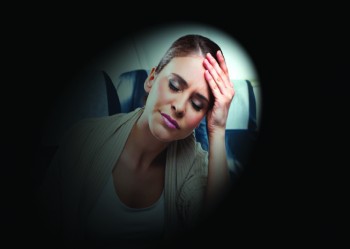How To Avoid Airsickness When Traveling?

 Air sickness is a special form of motion sickness, a sensation which is particularly induced by air travel. Air sickness occurs when the central nervous system receives conflicting messages from the body's inner ear, eyes and muscles. This affects balance and equilibrium. The inner ear helps in maintenance of balance and equilibrium, as it contains sensors for both angular and linear motion.
Air sickness is a special form of motion sickness, a sensation which is particularly induced by air travel. Air sickness occurs when the central nervous system receives conflicting messages from the body's inner ear, eyes and muscles. This affects balance and equilibrium. The inner ear helps in maintenance of balance and equilibrium, as it contains sensors for both angular and linear motion.
Motion sickness functions as a defense mechanism against neurotoxins. These neurotoxins are produced in the body whenever there is a conflict between vision and balance. The neurotoxins trigger the area in the brain responsible for inducing vomiting. When a person feels motion but cannot see it, the inner ear transmits to the brain that it senses motion, but the eyes tell the brain that everything is still. Due to this misinterpretation, the brain comes to the conclusion that the person is hallucinating. The brain responds by inducing vomiting to clear the neurotoxins.
What Are The Signs Of Airsickness/Motion Sickness?
If a person is suffering from airsickness, he/she may experience nausea, vomiting, vertigo, appetite loss, cold sweats, pale skin, difficulty concentrating, confusion, drowsiness, headache and increased fatigue. If the airsickness is severe, it may cause a person to be incapacitated.
Fatigue, stress and anxiety are some factors that increase susceptibility to motion sickness of any type. Besides drinking alcohol, certain drugs and medication also contribute to airsickness. Furthermore, airsickness is common in women (especially during menstruation or pregnancy), young children and individuals prone to other types of motion sicknesses. People who travel on long-haul flights are more prone to airsickness than short-haul flights. Although airsickness is not common among experienced pilots, it may occur in some frequencies among trainee pilots.
How To Cure Airsickness/Motion Sickness?
Follow these tips if you need to take precautionary measures against motion sickness or airsickness:
-
Sit near the front or beside the wings in an aircraft. These areas experience less motion. Getting a window seat helps as well, as you can focus your eyes on the horizon when you feel nauseous to calm your motion sickness.
-
Avoid consuming large meals and foods that are greasy, salty, spicy, fatty or salty. Do not consume any alcohol, but drink plenty of water. You can eat snacks and small frequent meals.
-
It is believed that drinking carbonated beverages can also lessen nausea.
-
Avoid reading during flight and this creates a dissonance when focusing on a stationary page when your body is in motion.
-
It's believed that acupressure reduces nausea. Applying pressure on the inside of your wrist reduces nausea.
-
ENT doctors also prescribe medicines that alleviate the symptoms of air sickness. However, pilots are advised not to take airsickness medicines as it may cause people to be drowsy or affect brain functions in other ways. Repeated exposure to flight environment decreases the susceptibility to subsequent airsickness.
-
If all else fails and you feel nauseated, you can use the sickness bag which is usually located in the back of passenger seats on aircraft. These bags have been in use since the 1950s.
